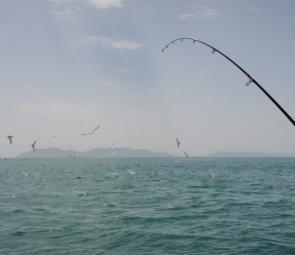Deep into winter, the species on every angler’s lips in Bowen will be Spanish mackerel.
These fish are by far the premier sportfish for trailer boat fishers in the north for a variety of reasons:
Firstly, they are large, fast, and fight like hell. Whether you are chasing them on live bait, jig or trolled lures or bait they all love to peel braid off a reel with ease.
Secondly, Spaniards are clean fighters and present anglers with plenty of opportunity to chase big trophy-sized fish on light tackle as they rarely head for the rocks or reef.
Thirdly, they are fantastic on the plate, especially fresh and it can be hard to beat a battered piece of fresh Spanish mackerel, especially after a hard day’s fishing.
Finally, they are abundant during this time of year and multiple catches of big fish are not uncommon particularly when you focus on getting a few key variables right.
Whether you are trolling, jigging or live baiting you need to be fishing areas that are renowned for mackerel. These areas include rubble patches and shoals, island fringing reef and even isolated rocks. Bowen has an ample supply of Spanish mackerel spots.
The first spot to have a crack at is around the islands that sit within Sinclair Bay. The closer in islands like Stone and Lighthouse are only a couple of kilometres offshore but are prime spots to troll for Spanish mackerel. The funnel between these two islands often serves as a highway for big Spaniards when the tide is running and bait is present on the surface.
The islands like Middle and Glouster generally hold larger fish averaging around the 15-20kg mark. These fish love to patrol the fringing reef drop-offs hunting on fusiliers, trevally and queenfish. These are great spots to troll large lures and live baits and the best time is when the tide is really moving the fastest. When trolling around the islands I love to fish the bottom of the tide. Getting the first hour of the run-in is when the bite is often the hottest for these fish.
While the islands are a very good Spanish mackerel option, Bowen also has some terrific rubble patches and wrecks which hold big populations of pelagic species, not just Spanish mackerel. These rubble patches and wrecks are all well marked on a Navionics marine chart or chart plotter.
These spots come alive during the winter months as they serve as a great spot for bait to reside and for larger predatory fish to gather. These isolated spots are better fished using jigs like Bumper Bars or large knife jigs. These need to be fished at speed as the slashing high speed movement through the water is what often drives these fish to attack.
Whatever method you use make sure you are using plenty of wire as the razor teeth of these fish will easily slice through even the toughest of mono or fluorocarbon leader.
While the larger Spanish mackerel are always desirable, the smaller grey and spotted macks will also be out in full force during July in Bowen. The infamous Bowen Mackerel Patches are the best place to snare a good haul of these fish, especially if the water is clear and flat. We had a cracker of a year out on the Patches last year with all three inshore spots producing Spanish, spotted and some extra oversized greys as well. There were also a few marlin landed out there as well and there are many Bowen anglers hoping to have a shot at these bill fish again in 2013.
The offshore fishing is outstanding in July, and the creeks are also well worth a fish. The cold water will dampen the spirits of the barra and jacks a little, however these fish still need to feed so they are still a viable target.
There are many good tips to cold water luring but the most important is to find the areas in the creeks where there is a rise in water temperature. This is where using a sounder is key to success as finding that 1ºC rise can often be the difference between success and failure.
Fishing light is also important as the fish are a little wearier, especially considering the clarity of the water through the cooler months. Dominant southwest winds keep inshore areas calm even in relatively windier days, which sees many of the creeks run very clear. This can be problematic if you are using heavy leaders so light fluorocarbon leaders are a must.
Other species also on cards for lure fishers in the creeks are sand specimens like flathead, grunter and whiting, which are all on the chew. I love chasing flathead through winter as they are prolific and large during the cooler months. These fish are great to target over the flats with small surface lures or soft plastics. This is visually exciting and very productive.
Next month the same pattern should continue and the run of pelagics should reach its peak. The water outwide will begin to really clean up and this should see some billfish action outwide around the reefs. The bait in the bay will continue to be prolific and August is a top time for chasing pelagic fish off the surface. Feeding bait balls really become common place this time of year and become very hard to drive past, especially when there is such a mix of fish on offer.
Reads: 1457
Don’t put the baitcasters away in July, jacks will still be on the chew especially if you can find the pockets of warner water.


Next month is all about bait ball action – it doesn’t get much more exciting then this!




